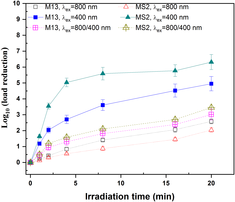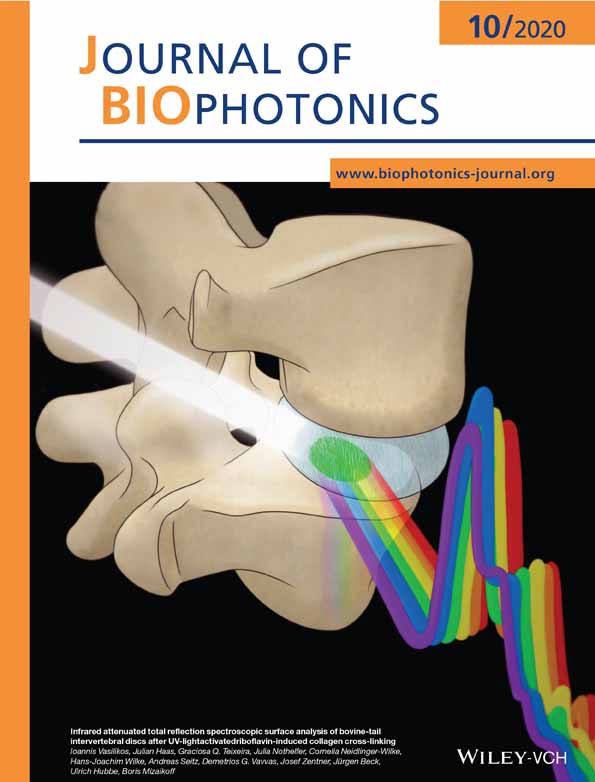Comparative study on the inactivation of MS2 and M13 bacteriophages using energetic femtosecond lasers
Aziz Berchtikou
INRS – Centre Énergie Matériaux Télécommunications, Varennes, Québec, Canada
Search for more papers by this authorEsen Sokullu
INRS – Centre Énergie Matériaux Télécommunications, Varennes, Québec, Canada
Search for more papers by this authorSharifun Nahar
INRS – Centre Énergie Matériaux Télécommunications, Varennes, Québec, Canada
Search for more papers by this authorPeter Tijssen
INRS – Centre Armand-Frappier Santé Biotechnologie, Laval, Québec, Canada
Search for more papers by this authorMarc A. Gauthier
INRS – Centre Énergie Matériaux Télécommunications, Varennes, Québec, Canada
Search for more papers by this authorCorresponding Author
Tsuneyuki Ozaki
INRS – Centre Énergie Matériaux Télécommunications, Varennes, Québec, Canada
Correspondence
Tsuneyuki Ozaki, INRS – Centre Énergie Matériaux Télécommunications, 1650 Boulevard Lionel-Boulet, Varennes, Québec J3X 1S2, Canada.
Email: [email protected]
Search for more papers by this authorAziz Berchtikou
INRS – Centre Énergie Matériaux Télécommunications, Varennes, Québec, Canada
Search for more papers by this authorEsen Sokullu
INRS – Centre Énergie Matériaux Télécommunications, Varennes, Québec, Canada
Search for more papers by this authorSharifun Nahar
INRS – Centre Énergie Matériaux Télécommunications, Varennes, Québec, Canada
Search for more papers by this authorPeter Tijssen
INRS – Centre Armand-Frappier Santé Biotechnologie, Laval, Québec, Canada
Search for more papers by this authorMarc A. Gauthier
INRS – Centre Énergie Matériaux Télécommunications, Varennes, Québec, Canada
Search for more papers by this authorCorresponding Author
Tsuneyuki Ozaki
INRS – Centre Énergie Matériaux Télécommunications, Varennes, Québec, Canada
Correspondence
Tsuneyuki Ozaki, INRS – Centre Énergie Matériaux Télécommunications, 1650 Boulevard Lionel-Boulet, Varennes, Québec J3X 1S2, Canada.
Email: [email protected]
Search for more papers by this authorFunding information: Natural Sciences and Engineering Research Council (NSERC) of Canada
Abstract
Femtosecond (fs) laser irradiation techniques are emerging tools for inactivating viruses that do not involve ionizing radiation. In this work, the inactivation of two bacteriophages representing protective capsids with different geometric constraints, that is, the near-spherical MS2 (with a diameter of 27 nm) and the filamentous M13 (with a length of 880 nm) is compared using energetic visible and near-infrared fs laser pulses with various energies, pulse durations, and exposure times. Intriguingly, the results show that inactivation using 400 nm lasers is substantially more efficient for MS2 compared to M13. In contrast, using 800 nm lasers, M13 was slightly more efficiently inactivated. For both viruses, the genome was exposed to a harmful environment upon fs-laser irradiation. However, in addition to the protection of the genome, the metastable capsids differ in many properties required for stepwise cell entry that may explain their dissimilar behavior after (partial) disassembly. For MS2, the dominant mechanism of fs-laser inactivation was the aggregation of the viral capsid proteins, whereas aggregation did not affect M13 inactivation, suggesting that the dominant mechanism of M13 inactivation was related to breaking of secondary protein links.
REFERENCES
- 1P. Hellstern, Curr. Opin. Hematol. 2004, 11, 346.
- 2G. Rock, Vox Sang. 2011, 100, 169.
- 3J. P. AuBuchon, ISBT Sci. Ser. 2011, 6, 181.
10.1111/j.1751-2824.2011.01471.x Google Scholar
- 4H. J. Alter, Transfus. Med. Rev. 2008, 22, 97.
- 5G. Mateu, Arch. Biochem. Biophys. 2013, 531(1–2), 65.
- 6A. A. Simpson, B. Hébert, G. M. Sullivan, C. R. Parrish, Z. Zádori, P. Tijssen, M. G. Rossmann, J. Mol. Biol. 2002, 315(5), 1189.
- 7Z. Zádori, J. Szelei, M. C. Lacoste, Y. Li, S. Gariépy, P. Raymond, M. Allaire, I. R. Nabi, P. Tijssen, Dev. Cell 2001, 1(2), 291.
- 8A. Shepley-McTaggart, H. Fan, M. Sudol, R. N. Harty, J. Biol. Chem. 2020, 295(14), 4604.
- 9K.-T. Tsen, S.-W. D. Tsen, C.-L. Chang, C.-F. Hung, Proc. SPIE 2008, 6854, 68540N1.
10.1117/12.791305 Google Scholar
- 10K.-T. Tsen, S.-W. D. Tsen, C.-F. Hung, T. C. Wu, J. G. Kiang, J. Phys. Condens. Matter 2008, 20, 252205.
- 11K.-T. Tsen, S.-W. D. Tsen, Q. Fu, S. M. Lindsay, K. Kibler, B. Jacobs, T. C. Wu, K. Balasubramanyam, S. Jagu, R. B. S. Roden, J. Biomed. Opt. 2009, 14, 064042.
- 12S.-W. D. Tsen, Y.-S. D. Tsen, K.-T. Tsen, T. C. Wu, J. Healthc. Eng. 2010, 1(2), 185.
- 13K.-T. Tsen, S.-W. D. Tsen, Q. Fu, S. M. Lindsay, Z. Li, S. Cope, S. Vaiana, J. G. Kiang, J. Biomed. Opt. 2011, 16(1–8), 078003.
- 14S.-W. D. Tsen, T. C. Wu, J. G. Kiang, K.-T. Tsen, J. Biomed. Sci. 2012, 19, 62.
- 15S.-W. D. Tsen, T. Chapa, W. Beatty, K.-T. Tsen, D. Yu, S. Achilefu, J. Biomed. Opt. 2012, 17(12), 128002.
- 16S.-W. D. Tsen, D. H. Kingsley, C. C. Poweleit, S. Achilefu, D. S. Soroka, T. C. Wu, K.-T. Tsen, Virol. J. 2014, 11, 20.
- 17S.-W. D. Tsen, K. Kibler, B. Jacobs, J. C. Fay, N. P. Podolnikova, S. Achilefu, K.-T. Tsen, IEEE J. Sel. Top Quantum Electron. 2016, 22(3), 1.
- 18S.-W. D. Tsen, D. H. Kingsley, K. Kibler, B. Jacobs, S. Sizemore, S. M. Vaiana, J. Anderson, K.-T. Tsen, S. Achilefu, PLoS One 2014, 9(11), 1.
- 19H. Kruse, A.-M. Kirkemo, K. Handeland, Emerg. Infect. Dis. 2004, 10(12), 2067.
- 20T. Kuiken, F. A. Leighton, R. A. Fouchier, J. W. LeDuc, J. S. Peiris, A. Schudel, K. Stöhr, A. D. Osterhaus, Science 2005, 309, 1680.
- 21A. Berchtikou, A. A. Greschner, M. A. Gauthier, P. Tijssen, T. Ozaki, J. Biophotonics 2019, 13(2), e201900001.
- 22D. W. Banner, C. Nave, D. A. Marvin, Nature 1981, 289(5800), 814.
- 23K. Valegård, L. Liljas, K. Fridborg, Nature 1990, 345(6270), 36.
- 24D. Strickland, G. Mourou, Opt.Commun. 1985, 55(6), 447.
- 25A. H. Geeraerd, V. P. Valdramidis, J. F. Van Impe, Int. J. Food Microbiol. 2005, 102, 95.
- 26A. Bevilacqua, B. Speranza, M. Sinigaglia, M. R. Corbo, Foods 2015, 4, 565.
- 27I. R. Booth, Int. J. Food Microbiol. 2002, 78, 19.
- 28B. F. Brehm-Stecher, E. A. Johnson, Microbiol. Mol. Biol. Rev. 2004, 68(3), 538.
- 29P. Mafart, O. Couvert, S. Gaillard, I. Leguerinel, Int. J. Food Microbiol. 2002, 72, 107.
- 30M. Peleg, M. B. Cole, Crit. Rev. Food Sci. Nutr. 1998, 38, 353.
- 31P. J. Klasse, Prog. Mol. Biol. Transl. Sci. 2015, 129, 285.
- 32O. Cerf, J. App. Bacteriol. 1977, 42, 1.
- 33A. H. Geeraerd, C. H. Herremans, J. F. Van Impe, Int. J. Food Microbiol. 2000, 59, 185.
- 34E. C. Dykeman, O. F. Sankey, J. Phys. Condens. Matter 2009, 21, 505102.
- 35E. C. Dykeman, D. Benson, K.-T. Tsen, O. F. Sankey, Phys. Rev. E 2009, 80, 041909.
- 36R. C. Prince, R. R. Frontiera, E. O. Potma, Chem. Rev. 2017, 117(7), 5070.
- 37L. Dhar, J. A. Rogers, K. A. Nelson, Chem. Rev. 1994, 94, 157.
- 38M. Nazari, X. Li, M. A. Alibakhshi, H. Yang, K. Souza, C. Gillespie, S. Gummuluru, M. Hong, B. M. Reinhard, K. S. Korolev, L. D. Ziegler, Q. Zhao, M. Wanunu, S. Erramilli, Nano Futures 2018, 2, 1.
- 39M. Nazari, M. Xi, M. Aronson, O. Mcrae, M. K. Hong, S. Gummuluru, A. E. Sgro, J. C. Bird, L. D. Ziegler, C. Gillespie, K. Souza, N. Nguyen, R. M. Smith, E. Silva, A. Miura, S. Erramilli, B. M. Reinhard, Appl. Nanomater. 2019, 2(4), 2548.
- 40G. F. Reddish, Am. J. Public Health (N. Y.) 1926, 16(3), 283.
- 41M. Maclean, S. J. Mac Gregor, J. G. Anderson, G. Woolsey, FEMS Microbiol. Lett. 2008, 285(2), 227.
- 42J. G. Anderson, N. J. Rowan, S. J. MacGregor, R. A. Fouracre, O. Farish, IEEE Trans. Plasma Sci. 2000, 28, 83.
- 43H. Ashkenazi, Z. Malik, Y. Harth, Y. Nitzan, FEMS Immunol. Med. Microbiol. 2003, 35, 17.
- 44P. Gaspard, I. Burghardt, Advances in Chemical Physics, Chemical Reactions and Their Control on the Femtosecond Time Scale, Vol. no. 101. 20th Solvay Conference on Chemistry, Wiley-Interscience, New York, 1997, p. 96.
- 45A.-M. Sapse, Molecular Orbital Calculations for Biological Systems, Oxford University Press, New York, 1998, p. 256.
- 46F. S. Barnes, B. Greenebaum, Biological and Medical Aspects of Electromagnetic Fields, CRC Press, Boca Raton 2006, p. 371.
- 47L. Chieh Han, K. H. Lin, Y. Y. Hsu, K.-T. Tsen, Y. K. Kuan, J. Phys. D Appl. Phys. 2014, 47, 315402.
- 48E. L. Nussbaum, L. Lilge, T. Mazzulli, J. Clin, Laser Med. Surg. 2002, 20(6), 325.
- 49R. Lubart, A. Lipovski, Y. Nitzan, H. Friedmann, Laser Ther. 2011, 20(1), 17.
- 50S. J. Guffey, J. Wilborn, Photomed. Laser Surg. 2006, 24(6), 680.
- 51J. A. Glasel, Biotechniques 1995, 18, 62.
- 52H. A. Scheraga, J. Protein Chem. 1987, 6, 61.
- 53A. Bruce, A. Johnson, J. Lewis, M. Raff, K. Roberts, P. Walter, Molecular Biology of the Cell, Garland Science, New York 2008, p. 585.
- 54V. Lobo, A. Patil, A. Phatak, N. Chandra, Pharmacogn. Rev. 2010, 4(8), 118.
- 55R. Crupi, D. Impellizzeri, E. Gugliandolo, M. Cordaro, R. Siracusa, D. Britti, S. Cuzzocrea, R. Di Paola, J. Ocul. Pharmacol. Ther. 2019, 35, 571.
- 56B. Michen, T. Graule, J. Appl. Microbiol. 2010, 109(2), 388.
- 57C. P. Gerba, Adv. Appl. Microbiol. 1984, 30, 133.
- 58C. P. Gerba, S. R. Farrah, S. M. Goyal, C. L. Wallis, J. L. Melnick, Appl. Environ. Microbiol. 1978, 35(3), 540.
- 59C. Carbonnaux, R.-K. Madeleine, A. Ducruix, Protein Sci. 1995, 4(10), 2123.
- 60S. Finet, S.-P. Feriel, M. Casselyn, F. Bonnete, A. Tardieu, Curr. Opin. Coll. Interf. Sci. 2004, 9(1–2), 112.
- 61M. M. Ries-Kautt, A. F. Ducruix, J. Biol. Chem. 1989, 264(2), 745.
- 62R. Floyd, Appl. Environ. Microbiol. 1979, 38(5), 980.
- 63D. Dong, S. Sutaria, J. Y. Hwangbo, C. P. Pengxiao, Appl. Microbiol. Biotechnol. 2013, 97(18), 3514.
- 64C. Dika, J. F. Duval, G. Francius, A. Perrin, C. Gantzer, J. Colloid Interface Sci. 2015, 446, 327.
- 65R. Floyd, D. G. Sharp, Appl. Environ. Microbiol. 1978, 35(6), 1084.
- 66J. Langlet, F. Gaboriaud, C. Gantzer, J. F. L. Duval, Biophys. J. 2008, 94 (8, 3293.
- 67J. Langlet, F. Gaboriaud, J. F. L. Duval, C. Gantzer, Water Res. 2008, 42(42 (10–11), 2769.
- 68J. Langlet, L. Ogorzaly, J.-C. Schrotter, C. Machinal, F. Gaboriaud, J. F. L. Duval, C. Gantzer, J. Memb. Sci. 2009, 326, 111.
- 69J. Langlet, F. Gaboriaud, C. Gantzer, J. Appl. Microbiol. 2007, 13, 1632.
- 70F. Galdiero, Arch. Virol. 1979, 59(1–2), 99.
- 71A. Sagrera, C. Cobaleda, S. Berger, M. J. Marcos, V. Shnyrov, E. Villar, Biochem. Mol. Biol. Int. 1998, 46(3), 429.
- 72S. Y. Lee, J. N. Culver, M. T. Harris, J. Coll. Interf. Sci. 2006, 297(2), 554.
- 73P. A. Shields, S. R. Farrah, Appl. Environ. Microbiol. 1983, 45(2), 526.
- 74S. A. Overman, D. M. Kristensen, P. Bondre, B. Hewitt, G. J. Thomas Jr., Biochemistry 2004, 43(41), 13129.
- 75L. G. Shi Sanyal, A. Ni, Z. Luo, S. Doshna, B. Wang, T. L. Graham, N. Wang, D. B. Volkin, J. Pharm. Sci. 2005, 94(7), 1538.
- 76T. Sigstam, A. Rohatschek, Q. Zhong, M. Brennecke, T. Kohn, Water Res. 2014, 48, 82.
- 77M. J. Mattle, B. Crouzy, M. Brennecke, K. R. Wigginton, P. Perona, T. Kohn, Environ. Sci. Technol. 2011, 45(18), 7710.
- 78A. P. Minton, Curr. Opin. Biotechnol. 1997, 8, 65.
- 79A. P. Minton, Curr. Opin. Struct. Biol. 2000, 10, 34.
- 80D. Homouz, M. Perham, A. Samiotakis, M. S. Cheung, P. Wittung-Stafshede, Proc. Natl. Acad. Sci. USA 2008, 105, 11754.
- 81A. Philippe, G. E. Schaumann, Environ. Sci. Technol. 2014, 48, 8946.
- 82M. Baalousha, Sci. Total Environ. 2009, 407, 2093.




